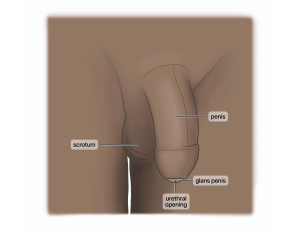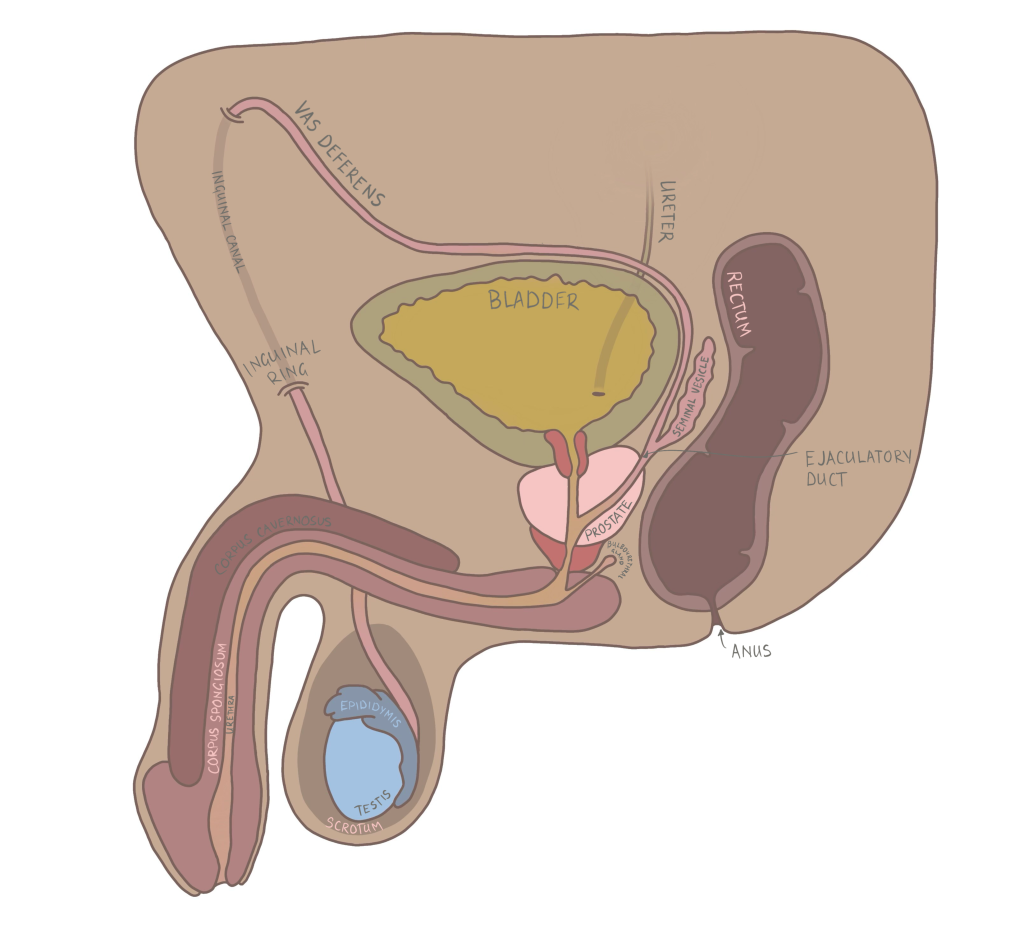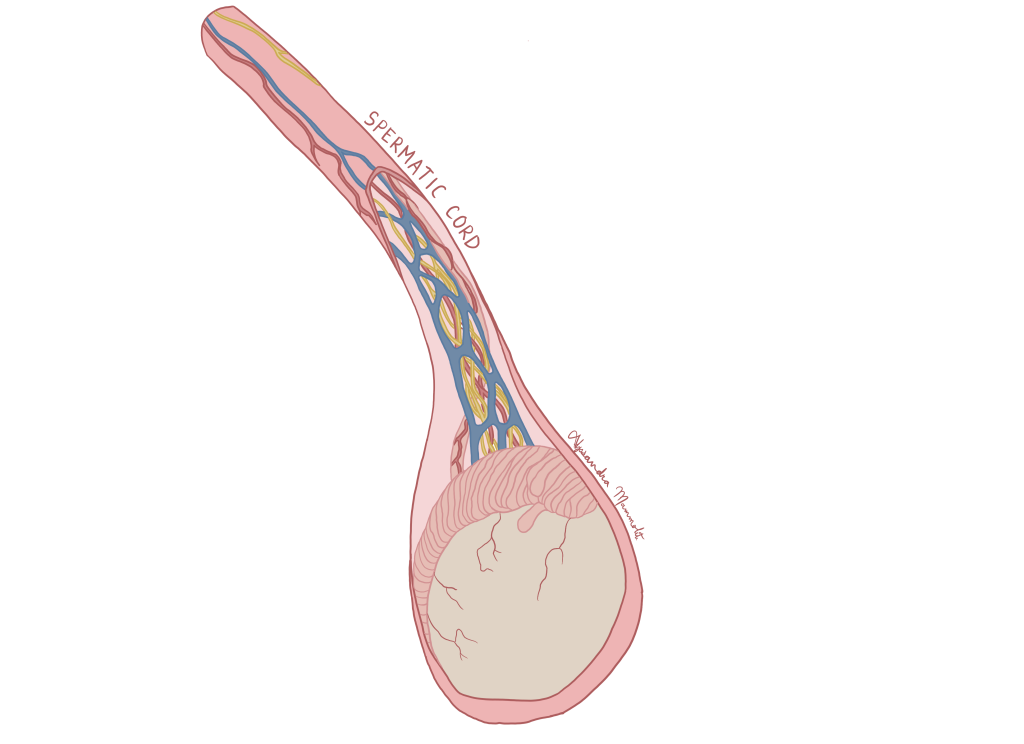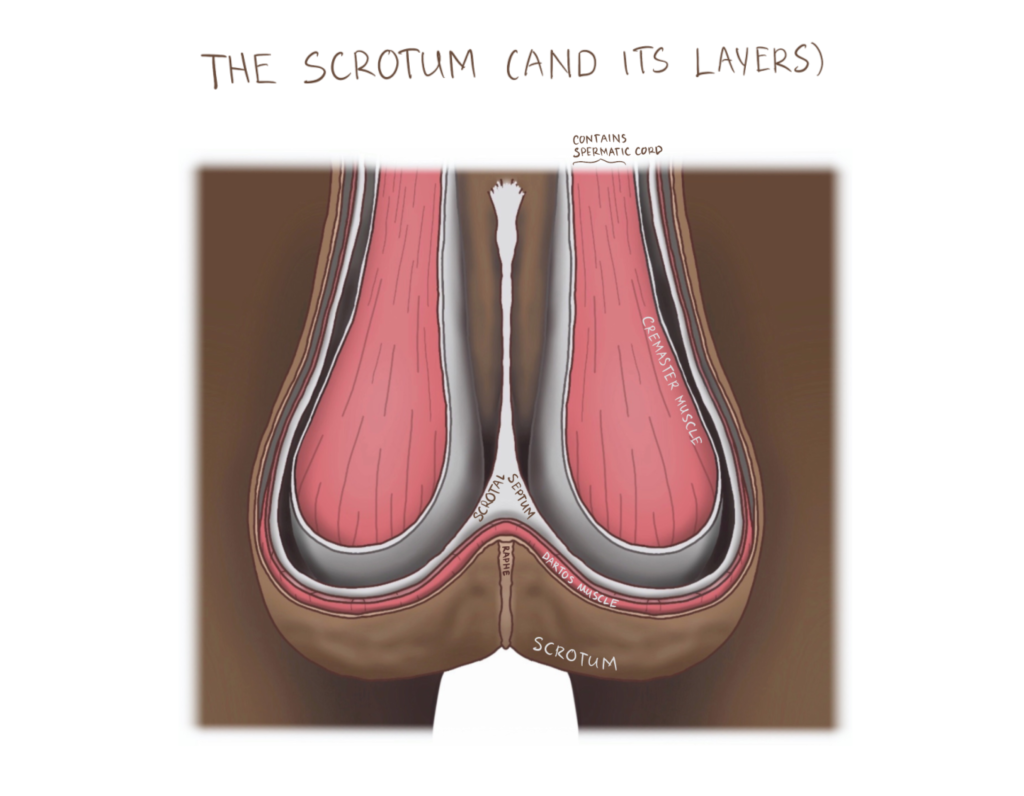25 Male Perineum and External Genitalia
Male genitalia:
The male genitalia – including the penis, scrotum and testes – can be thought of as an integrated manufacturing and delivery system for semen. The spermatozoa (sperm) manufactured in the testes are supplemented by a number of secretions along their way to make semen. This semen is delivered to the urethra which exits the penis.

Figure 57 Male genitalia

Figure 58 Cross-sectional view of male reproductive system
The penis consists of two parts: the body and root. The root is the base of the penis which attaches to the pelvic bones. The root contains the two muscular, leg-like crura on the outside and the bulb in between. The crura are anchored to the ischial bones and extend outward as the corpora cavernosa which form the main erectile components of the penis. The bulb lies in the midline of the perineum and extends forward as the corpus spongiosum. The paired corpora cavernosa and the corpus spongiosum make up the cylindrical body of the penis – also referred to as the shaft. The corpus spongiosum extends to become the glans, or tip, of the penis. Running from the bladder through the corpus spongiosum to its outlet at the glans, is the urethra.
View the diagram below for a visual representation of the male genitalia:

Figure 59 posterior view of male genitalia
Figure 60 Anterior view of male genitalia
Erectile Tissue:
The cylindrical body of the penis – also referred to as the shaft – which extends from the root to the glans (the most distal portion). The body contains 3 columns of erectile tissue:
- Corpora cavernosa (2): These two cylindrical tissues extend from the crura and run along the dorsal (downward pointing) aspect of the penis, and maintain rigidity during erection.
- Corpus Spongiosum: The single ventral column that surrounds the urethra. This tissue prevents the urethra from being compressed allowing ejaculation.
- The distal ends of the spongiosum forms the cap-like glans.

Figure 61 Cross-sectional view penile erectile tissue
In summary the penis functions as both a reproductive and urinary organ, with its structure optimized to support erection, ejaculation, and the passage of urine. The coordinated roles of the root, body, and glans ensure effective delivery of sperm during reproduction while maintaining the integrity of the urethra.
The Scrotum:
The scrotum is the sac-like structure that sits inferior to the penis. It plays a vital role in housing and supporting the two sets of testis, epididymis, and the initial part of the spermatic cord.
Table 27 Male reproductive structures
| Structure | Description |
| Testes | The primary male reproductive organ responsible for producing sperm and testosterone. Within the testes, seminiferous tubules produce millions of sperm daily via spermatogenesis. |
| Epididymis | A long, coiled tube located at the posterior side of a testis where sperm mature and are stored. This tube-like structure continues to the inferior pole of the testes where it reaches the vas deferens which conducts the sperm to the urethra. |
| Spermatic cord | The vas deferens and a bundle of nerves, blood vessels, lymphatic vessels which connects the testes to the abdominal cavity. |
View the diagram below for a representation of the male perineum:

Figure 62 Sagittal view of the scrotum
Scrotum temperature regulation:
The sperm need to be a couple of degrees colder than normal body temperature to develop properly. The lower temperature is maintained by the scrotum and the heat exchange mechanism of the testicular veins. The scrotum has two muscles, the dartos and cremaster which are key. The dartos muscle in the scrotal wall relaxes to allow for a large scrotal surface area for cooling while the cremaster muscle lowers scrotum from the body wall to decrease scrotal temperature.
The diagram below outlines the muscular placements of these temperature regulating areas:

Figure 63 Anterior view of the scrotum and its layers
Check out this meme!

Hint: This meme is showcasing the importance of the scrotum in the male reproductive system, listing out its major functions.

